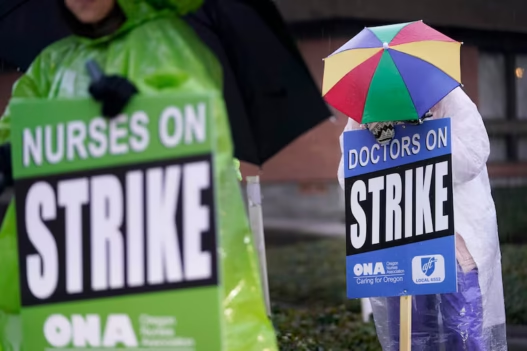I’ve reported on countless stories of systemic challenges in healthcare. But the largest healthcare strike in Oregon’s history is not just a headline—it’s a wake-up call for an industry already under immense pressure.
Thousands of nurses, doctors, and healthcare workers employed by Providence Health & Services have walked off the job, demanding better pay, improved staffing, and safer working conditions.
At its core, this strike is a fight for dignity—for workers and the patients they care for.
What’s Behind the Strike?
The workers’ grievances center on three main issues:
- Unsafe Staffing Levels: Many healthcare workers report that chronic understaffing is making it impossible to provide quality care.
Nurses are stretched thin, with some managing double or even triple the number of patients they can safely handle.
This compromises both patient safety and the well-being of the staff. - Fair Compensation: Workers argue that their wages have not kept pace with inflation or the increased demands of their roles.
Nurses and support staff say they are being asked to do more with less, all while facing stagnant pay and rising costs of living. - Burnout and Unsafe Conditions: Healthcare workers have borne the brunt of the COVID-19 pandemic and its aftermath.
Many report feeling burnt out, underappreciated, and at risk due to insufficient resources and support.
Providence Health & Services, one of the largest healthcare systems in the Pacific Northwest, has acknowledged these challenges but insists they are negotiating in good faith.
However, workers say the pace of negotiations has been too slow, forcing them to take action.
The strike has created immediate challenges for the healthcare system. Elective surgeries have been postponed, and some hospitals have diverted patients to other facilities.
For many in Oregon, this disruption is a stark reminder of just how fragile the healthcare system is when its workforce is pushed to the brink.
But for the striking workers, this fight is ultimately about improving care for their patients.
“We can’t take care of others if we’re drowning ourselves,” said one nurse.
By demanding better staffing and conditions, healthcare workers hope to create an environment where patients receive the attention and care they deserve.
Oregon’s healthcare strike reflects a larger crisis in the U.S. healthcare system.
Across the country, hospitals are struggling to retain staff, and burnout among healthcare workers is at an all-time high.
A 2022 survey revealed that nearly half of nurses were considering leaving the profession due to stress and inadequate support.
This isn’t just a labor issue—it’s a public health issue.
When healthcare workers are overworked and undervalued, patient outcomes suffer.
Longer wait times, reduced access to care, and higher rates of medical errors are just some of the consequences of a system that fails to invest in its workforce.
The Call for Change
The striking workers are calling for immediate action to address their concerns:
- Higher Staffing Ratios: Ensuring adequate staffing levels to protect both patients and workers.
- Fair Wages: Providing competitive pay that reflects the critical nature of healthcare work.
- Mental Health Support: Addressing burnout through counseling, peer support, and better working conditions.
For its part, Providence Health & Services has stated that they are committed to resolving the strike quickly and fairly.
However, workers insist that promises must be backed by concrete action.
The outcome of this strike will have ripple effects far beyond Oregon. If successful, it could set a precedent for healthcare workers across the country, empowering them to demand better treatment and resources.
Conversely, if the strike fails to achieve meaningful change, it could discourage other workers from speaking out and perpetuate the status quo.
As we watch this story unfold, one thing is clear: the demands of Oregon’s healthcare workers aren’t just about them—they’re about the future of healthcare itself.
A system that prioritizes profits over people will never deliver the care that patients deserve.
By standing up for fair treatment, these workers are advocating for a healthier, more sustainable system for everyone.
The largest healthcare strike in Oregon’s history is a defining moment for the state and the nation.
It’s a call to address the systemic issues that have pushed healthcare workers to their breaking point.
As negotiations continue, the hope is that this strike will lead to meaningful reforms that benefit not just workers but the patients who depend on them.
This is more than a labor dispute—it’s a fight for the soul of healthcare.























